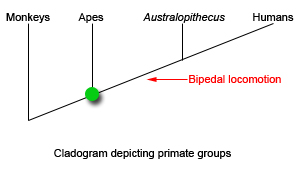Lucy’s evolutionary relationship to modern humans was one of the first questions asked by scientists after the “Lucy” discovery. The process of determining relatedness among organisms is called systematics. Unfortunately, we can’t travel back in time to answer this question. However, in one type of systematics called cladistics, we can understand the evolutionary relationships among organisms by grouping them together based on shared characters (traits) (See the eFossils lesson “Evolution: From the Beginning” for more information). Specifically, cladistics is concerned with features that are novel and unique, termed derived features, to a particular subset of animals within a larger group. For example, among mammals, primates have nails. Since, most other mammals have claws, nails are a derived primate feature. In contrast, characters that everyone in the larger group has are termed primitive characters. For example, primates have hair, but so do all mammals. In this case, hair is a primitive feature that primates share with all mammals. All organisms that share a derived character belong to a clade.
Humans and their fossil relatives all belong to a clade we refer to as hominins. This clade is defined, in part, by the shared ability to walk bipedally. Bipedalism refers to locomotion (how an animal moves or travels) on two legs. You move bipedally whenever you walk, jog, run, or skip. However, most other animals, including chimpanzees, use quadrupedalism, meaning to walk on four legs. Thus, although chimpanzees are our closest living relatives, they are not part of the hominin clade. Bipedal walking is unique to hominins, and is considered a novel acquisition since their divergence from the common ancestor that hominins share with the African great apes.
 The diagram shown left is called a cladogram (think: diagram of clades). A cladogram can contain living and/or extinct species, and tells about the relative timing of speciation events, or when species diverged from a common ancestor. By extension, cladograms also tell us about the relative antiquity (i.e., old age) of these ancestors. In the cladogram, each vertical line represents a general group of primates based on their taxonomic classifications (i.e., family, genus, species). The diagonal line (or line running horizontally) represents the ancestral species. The point where the vertical and horizontal lines meet is called a node, and represents a speciation event. Let’s walk through an example together. As mentioned, the “hominin” clade is defined by the ability to walk bipedally. Therefore, bipedal locomotion must have evolved after the divergence of hominins from living apes. That point is illustrated by placing “bipedal locomotion” after the node (large dot) where hominins and apes diverge.
The diagram shown left is called a cladogram (think: diagram of clades). A cladogram can contain living and/or extinct species, and tells about the relative timing of speciation events, or when species diverged from a common ancestor. By extension, cladograms also tell us about the relative antiquity (i.e., old age) of these ancestors. In the cladogram, each vertical line represents a general group of primates based on their taxonomic classifications (i.e., family, genus, species). The diagonal line (or line running horizontally) represents the ancestral species. The point where the vertical and horizontal lines meet is called a node, and represents a speciation event. Let’s walk through an example together. As mentioned, the “hominin” clade is defined by the ability to walk bipedally. Therefore, bipedal locomotion must have evolved after the divergence of hominins from living apes. That point is illustrated by placing “bipedal locomotion” after the node (large dot) where hominins and apes diverge.
Through analyses of Lucy’s skeletal morphology (see below), we are able to conclude that she walked bipedally. Therefore, we can conclude that Lucy is a hominin. Lucy belongs to the species A. afarensis that existed from 3.7 and 2.8 Ma2. There are many other extinct hominin species, but only one living hominin species: us, or Homo sapiens.
eFossils is a collaborative website in which users can explore important fossil localities and browse the fossil digital library. If you have any problems using this site or have any other questions, please feel free to contact us.
Funding for eFossils was provided by the Longhorn Innovation Fund for Technology (LIFT) Award from the Research & Educational Technology Committee (R&E) of the IT governance structure at The University of Texas at Austin.
